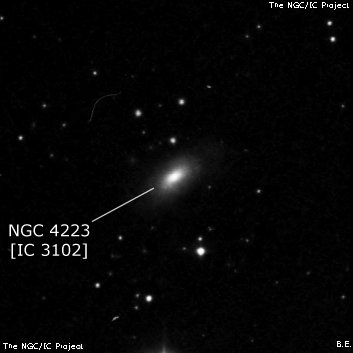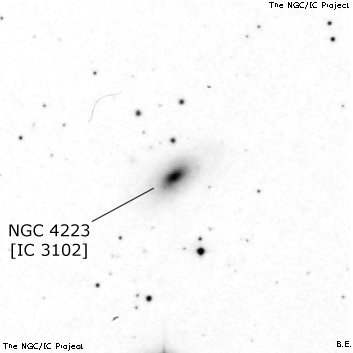NGC/IC Project Restoration Effort
(This is a very very beta version)
NGC4223


Basic Information
Location and Magnitude
Right Ascension: 12:17:25.8
Declination: +6:41:22
Constellation: VIR
Visual Magnitude: 11.9
Historic Information
Discoverer: Herschel W.
Year of discovery: 1784
Discovery aperture: 18.7
Observational
Summary description: pF, pL, R, r (? RA 10m)
Sub-type: S0-a
Corwin's Notes
=====
NGC 4223 = IC 3102 and NGC 4241 = IC 3115. There are several curious things
going on here, the least of which are the equalities with the IC numbers!
Here are two galaxies, both seen by both Herschels, yet Dreyer has all but
insisted on dropping the NGC number 4223. I'm not really in favor of this at
the end of the story -- but we need the story first.
WH found the brightest (H II 137) of the two galaxies on 13 April 1784,
placing it "f 11 Virginis 7 min 18 sec, 0 deg 55 arcmin north." As Dreyer
noted, these offsets reduce to 12 15 13, +06 58.6 (B1950). WH's second
observation, from 28 Dec 1784, reduces to 12 14 49, +07 00.1, which is close
to the actual position of the brighter galaxy of the pair. That these
observations refer to the same nebula is obvious from WH's note about III 480
(seen only on the second night): "L, vF, would not have been seen if it had
not been for the preceding [II 137]." WH's position for the fainter object
is also very close to the true position.
JH also has two observations of the brighter galaxy -- his positions are
accordant with each other, and with his father's second position. However --
and here is where the confusion sets in -- he calls this brighter galaxy III
480. On his second sweep, he also has an observation of an object which he
calls II 137, but of it he says, "pB, R, RA estimated from III 480, which it
precedes on the same parallel." All that is true. But the position he gives
for this brighter object is a minute of time earlier than it should be --
there is no nebula there. Somehow, JH has got his absolute positions about
a minute of time west of the true positions.
JH, of course, used his own positions in GC, and Dreyer copied them into the
NGC noting that d'A never saw the preceding of the pair. However, while
working on the Scientific Papers, Dreyer looked again at the problem, this
time finding that H III 480 is = IC 3115, and that II 137 = NGC 4241
(apparently not noticing that N4241 would also be = IC 3102 in this scenario).
This leaves the number 4223 without a galaxy -- yet WH's observations are very
clear that his II 137 applies to the brighter, western object. This would be
N4223. This makes the fainter eastern object III 480 = N4241. All this is in
accordance with the numbers in the GC and the NGC itself. The only incorrect
data are the RA's which are about a minute of time (N4223) and 30 seconds
(N4241) too far west.
This leads me to suggest that the simplest solution is to adopt WH's
positions, descriptions, and numbers. The only problem is that the number
N4241 has been applied to the brighter galaxy for so long that confusion will
undoubtedly result. My feeling is, "So be it."
The IC numbers are unambiguous as Schwassmann's positions are very good. The
question of why he did not assign the NGC numbers is pretty clear from the
mess above. I would have thought, however, that either he or Dreyer would
have caught the equality of the positions for I3102 and N4241 (as published in
NGC); apparently, neither checked carefully enough, perhaps thrown off by the
RA problems.
An addendum: The mess with these two NGC numbers may not be the reason that
Schwassmann did not assign them in his list -- he may simply have missed them.
There are at least two other NGC/IC equalities in his list: NGC 4235 = IC
3098, and NGC 4246 = IC 3113. There are no big problems with the NGC
positions in these cases, yet he has not put the NGC numbers into his list.
So, the galaxies also went into the IC. See those IC numbers for a bit more
discussion.
Steve's Notes
=====
NGC 4223
17.5" (3/24/90): moderately bright, fairly small, elongated WNW-ESE, bright core, larger faint extensions with averted. Located 5' N of mag 7.9 SAO 119308.
The galaxy described above is misidentified as NGC 4241 in modern catalogues. It forms a pair with IC 3115 (the "real" NGC 4241) 8' ESE.



